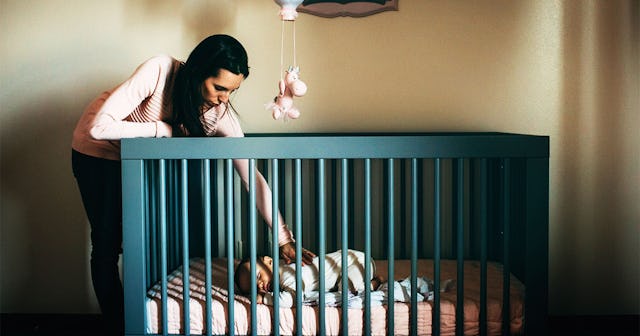Nearly Two-Thirds Of Parents Still Aren't Following Safe Infant Sleep Guidelines

Many parents are not following recommended safe sleep practices for their babies, says the AAP
When it comes to safe sleep for babies, we all know “back is best.” But that doesn’t mean all parents are following that recommendation, according to a new study from the American Academy of Pediatrics. There are plenty of potentially harmful hazards for babies if they aren’t kept safe at night, so it’s important for parents to stay informed.
Using maternal reports across 29 states of four different safe sleep practices regarding their infants, the study determined nearly two-thirds of mothers don’t follow the recommended guidelines for safe sleep practices. (Only mothers’ reports were used in the study, though it’s important to note that partners/fathers are also capable of following guidelines and putting their infants to sleep.)
Here are the four sleep practices used in the study to help prevent sudden unexpected infant death (SUID):
- “Back is best” — putting the infant to sleep on their back
- An approved sleep surface that is separate from that of the parents
- Room-sharing without bed-sharing
- No soft objects or loose bedding (i.e. stuffed animals and blankets) found in the infant sleep area
The study surveyed postpartum women nationwide, and it shows 78% of mothers are putting their babies to bed on their backs. But not nearly as many parents are following the AAP’s other recommendations. Only 57% are both room-sharing but not bed-sharing (where parents are not co-sleeping, but the baby is placed in a bassinet near the parents’ bed). Approximately 42% percent avoid soft bedding where the baby sleeps. And just 32% are using a separate, approved sleep surface like a crib or a bassinet.
“We have substantial room for improvement for these sleep practices,” Ashley H. Hirai, PhD, study author and senior scientist at the Maternal and Child Health Bureau of the U.S. Department of Health and Human Services tells SheKnows. “I think we need to do a better job, such as having better media campaigns in addressing the broader recommended practices, beyond ‘back to sleep.’”
In addition to following these sleep practices, a study published earlier this year found that parents should stop letting their infants sleep in their car seats. The 10-year study looked at factors in sleep-related deaths for 11,779 infants, and found that 3 percent of the deaths happened while the babies were in “sitting devices,” which included car seats, strollers and swings.
Of those, 64 percent happened in car seats, specifically to infants a median age of two months old. And 90 percent of the times infant death occurred in a car seat, the seat wasn’t being used correctly. In other words, the baby was in it while not traveling in a car, which is the only time a car seat should be used, the study says.
“The bottom line is to raise awareness about these better sleep recommendations,” Hirai said. “And so we just want to hit that home that the safest place for babies to sleep is on their back, on a separate [approved crib, bassinet or pack and play], without any soft bedding and that they should be in the same room as their caregivers.”
This article was originally published on